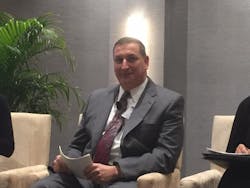WASHINGTON D.C. If all the unfinished rulemaking left over from the two and a half year MAP-21 highway bill passed back in 2012 didn’t create enough of a regulatory workload for various transportation agencies, the five-year FAST Act passed last December is going to add more.
“There are six rulemakings we see coming out of the FAST Act,” noted Walter ‘Butch’ Waidelich Jr., associate administrator of the Federal Highway Administration (FHWA), during a presentation this week at the American Association of State Highway and Transportation Officials (AASHTO) annual Washington Briefing held this week in the nation’s capital.
That’s in addition to ongoing FHWA performance management rulemaking efforts in four areas originally mandated by MAP-21, he said.
“These are truly interesting times as we make a strong push to implement MAP-21 rulemakings and prepare for the ones from the FAST Act,” Waidelich said, stressing that FHWA is focused on ensuring in the haste to get them done no errors are made.
“The last thing we want to do is rush a final rule out and then have to follow it with another rulemaking to fix it,” he pointed out.Waidelich (at right) said the MAP-21 FHWA rulemaking effort he is most involved with – the National Highway Performance Program – should be issued by August this year.
The FHWA rulemaking effort that will impact the trucking industry most directly – the Freight Movement Performance Program – should also be issued soon; work that is being accompanied by a series of “freight roundtables” held by the agency across the U.S., Waidelich said.
“We launched this effort earlier this month,” he noted. “We’ve held three so far in Miami, Atlanta, and Tucson (AZ) and 20 more are coming. They are designed to bring government and shipping companies together to help form national freight strategies.”
Waidelich added that those “strategies” will include ways to stress to the general public the connection between freight and jobs.
“It’s not just the jobs created by [transportation] infrastructure construction; it’s also the jobs created by the freight economy,” he said.
“Because we’re at a decision point now: Are we going to build a transportation system for the 21st century? Or are we going to punt?”
About the Author
Sean Kilcarr
Editor in Chief
Sean Kilcarr is a former longtime FleetOwner senior editor who wrote for the publication from 2000 to 2018. He served as editor-in-chief from 2017 to 2018.

